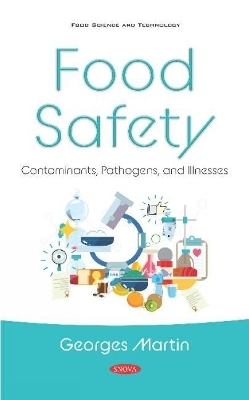
Food Safety
Contaminants, Pathogens, and Illnesses
Seiten
2019
Nova Science Publishers Inc (Verlag)
978-1-5361-6762-7 (ISBN)
Nova Science Publishers Inc (Verlag)
978-1-5361-6762-7 (ISBN)
The Food and Drug Administration (FDA) is responsible for overseeing the safety of about 80 percent of the nation's food supply and for promoting good nutrition. Chapter 1 reviews FDA's food safety- and nutrition-related activities and resources. Arsenic, an element in the earth's crust, can be harmful to human health and may be present in water and certain foods, such as rice. Chapter 2 examines what the National Research Council (NRC) and recent key scientific reviews have reported about the effects of ingestion of arsenic on human health, the extent to which FDA and USDA have managed the risk to human health from arsenic in rice, and the extent to which FDA has coordinated with USDA and other federal agencies on actions to manage the risk. Most seafood consumed in the United States is imported, and about half of it is raised on fish farms. Because farmed seafood is raised in confined areas and susceptible to infections, farmers may use drugs like antibiotics. The use of unapproved drugs or the misuse of approved drugs may result in unsafe residues in seafood that can cause cancer or allergic reactions, according to FDA, which is charged with ensuring the safety of most seafood. Chapter 3examines how FDA helps ensure the safety of imported seafood from unsafe drug residues and ways the agency could strengthen its efforts; how FSIS helps ensure the safety of imported catfish from unsafe drug residues and ways the agency could strengthen its efforts; and the extent to which FDA and FSIS coordinate their oversight efforts. The U.S. food supply is generally considered safe, but the Centers for Disease Control and Prevention (CDC) estimate that Salmonella and Campylobacter in food cause about 2 million human illnesses per year in the United States. Chapter 4 reviews USDA's approach to reducing pathogens in meat and poultry products. The produce industry continues to be associated with a series of foodborne illness outbreaks across multiple U.S. states and Canada, resulting in hundreds of illnesses and hospitalizations, as well as kidney failure and death in some cases as reported in chapter 5. The Trump Administration is proposing to consolidate the federal government's primary food safety functions into a single federal agency based in the U.S. Department of Agriculture (USDA) as reported in chapter 6.
PrefaceFood Safety and Nutrition: FDA Can Build on Existing Efforts to Measure Progress and Implement Key ActivitiesFood Safety: Federal Efforts to Manage the Risk of Arsenic in RiceImported Seafood Safety: FDA and USDA Could Strengthen Efforts to Prevent Unsafe Drug ResiduesFood Safety: USDA Should Take Further Action to Reduce Pathogens in Meat and Poultry ProductsFoodborne Illnesses and Outbreaks from Fresh ProduceProposed Reorganization of U.S. Federal Food Safety AgenciesIndex.
| Erscheinungsdatum | 09.01.2020 |
|---|---|
| Verlagsort | New York |
| Sprache | englisch |
| Maße | 155 x 230 mm |
| Gewicht | 518 g |
| Themenwelt | Technik ► Lebensmitteltechnologie |
| ISBN-10 | 1-5361-6762-2 / 1536167622 |
| ISBN-13 | 978-1-5361-6762-7 / 9781536167627 |
| Zustand | Neuware |
| Haben Sie eine Frage zum Produkt? |
Mehr entdecken
aus dem Bereich
aus dem Bereich
Technologie, Chemie, Mikrobiologie, Analytik, Bedeutung, Recht
Buch | Hardcover (2023)
Verlag Eugen Ulmer
140,00 €


